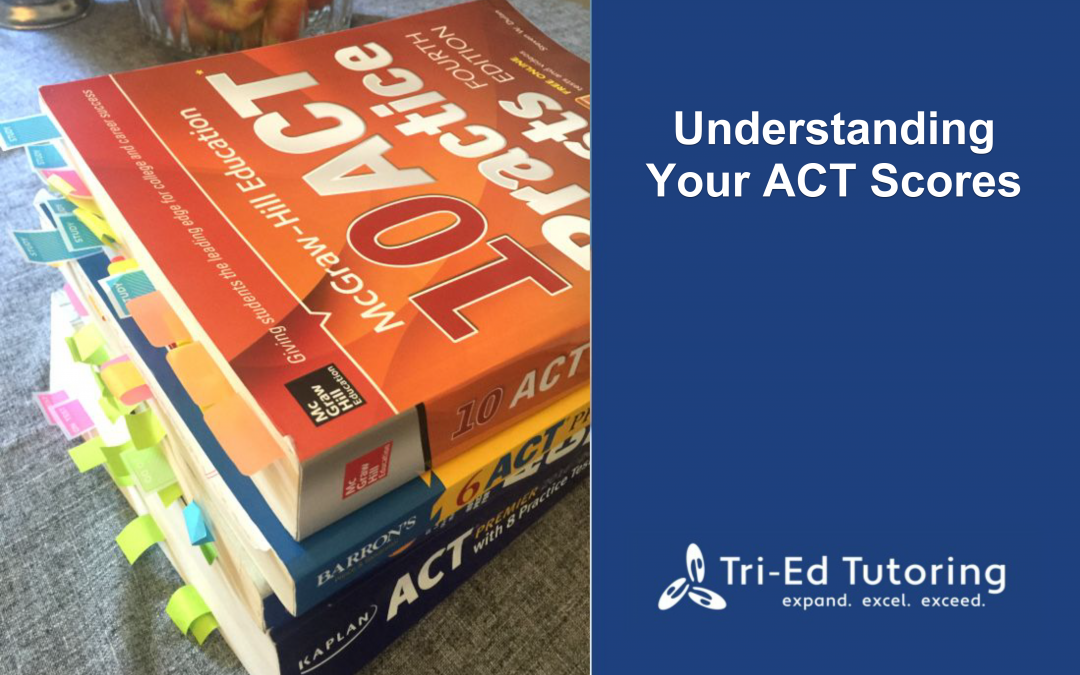The ACT score report provides detailed information to help you better understand your strengths and weaknesses in terms of ACT content. It’s worth taking the time to review your score report in detail before deciding if you should retake the ACT because your scores can guide your practice for the next SAT. You can see a sample score report here. The score report is broken down into the following components:
Composite score
This score is an average of the four subject test scores rounded to the nearest whole number. It ranges from 1 to 36 with a perfect score of 36. This score is indicated in the dark blue box in the top left corner. If your score is not within the average range for the colleges in which you plan to apply, you should retake the ACT and/or try the SAT.
Subject test scores
The math, science, English, and reading scores are derived from the number of correct answers in each subject’s section. Subject test scores are then scaled from 1 to 36. This information helps you determine your overall strengths and weaknesses and where you should focus your study time.
STEM and ELA scores
The STEM score averages the math and science subject test scores, while the ELA score averages the English and reading test scores. These scores are not calculated into the composite score, they simply break down the four subject test scores into two broader subject scores.
Graph
The graph under these scores provides a visual representation that can be used to easily compare subject test scores. The solid green and blue lines indicate your actual scores, and the shaded areas around the solid score lines represent your score range, which predicts where you might score if you took the test on a different day. The purple lines signify college readiness benchmarks, which predicts how ready a student is for college level work in that subject area.
Rank
In this section, your composite and subject score percentiles are compared to the score percentiles of other high school students who took the test on the same day. This gives you an idea of how you rank among other students across the country and state. For example, if your U.S. composite score percentile is 56% you scored at or better than 56 of 100 students nationwide. The higher your percentile, the greater advantage you can expect when applying to competitive schools.
Detailed results
The detailed results section breaks down subject test scores into subsections. This is the most valuable part of the score report for us as tutors since it gives specific information about the types of questions giving students trouble. Within each subsection, the number of correct answers versus the total number of questions in that section are identified, along with percentage correct and a visual bar graph to display the College Readiness Benchmark range.
Math
Preparing for Higher Math
- Number & Quantity: These questions focus on basic math, word problems, and general operations.
- Algebra: These questions focus on algebraic concepts, such as systems of equations, solving and graphing equations (including linear, polynomial, exponential, and radical), and matrices.
- Functions: These Algebra II questions focus on function notation and application including linear, quadratic, polynomial, logarithmic, and piecewise.
- Geometry: These questions focus on geometric concepts including area/perimeter/volume, triangles, circles, trigonometry, and conics.
- Statistics & Probability: These questions focus on mean/median/mode, ratios and proportions, probability, and data collection methods.
Integrating Essential Skills: These basic math questions focus on basic math topics primarily learned in middle school such as ratios, proportions, percent problems, and perimeter/area/volume, but ask students to apply these concepts to more complex or multi-step problems.
Science
- Interpretation of Data: These questions ask students to analyze scientific data presented in tables, graphs, and diagrams.
- Scientific Investigation: These questions focus on how a scientific experiment is set up and which scientific rules must be followed.
- Evaluation of Models, Inferences, & Experimental Results: These questions can be more challenging as they incorporate hypothetical scenarios and ask students to make inferences based on data from a scientific experiment.
English
- Production of Writing: These questions focus on the writing theme, development, and overall organization of a writing piece.
- Knowledge of Language: These questions focus on word choice, style of writing, and tone.
- Conventions of Standard English: These questions focus on punctuation such as commas, colons, semi-colons, and quotation marks as well as grammar rules. More than half of questions on the English subject test are categorized in this subsection.
Reading
- Key Ideas & Details: These questions focus on the central ideas and themes of a reading passage.
- Craft & Structure: These questions focus on the tone of a passage and analysis of a character’s perspectives and the author’s word choice.
- Integration of Knowledge & Ideas: These questions focus on fact versus opinion and require an understanding of how authors construct an argument. These questions also ask students to make connections between two different texts.
- Understanding Complex Texts: This indicates whether you are understanding the texts at a level that is necessary to succeed in reading-heavy college courses.
*The ACT writing section is optional. Since very few colleges require writing scores we often recommend students opt out of this section

